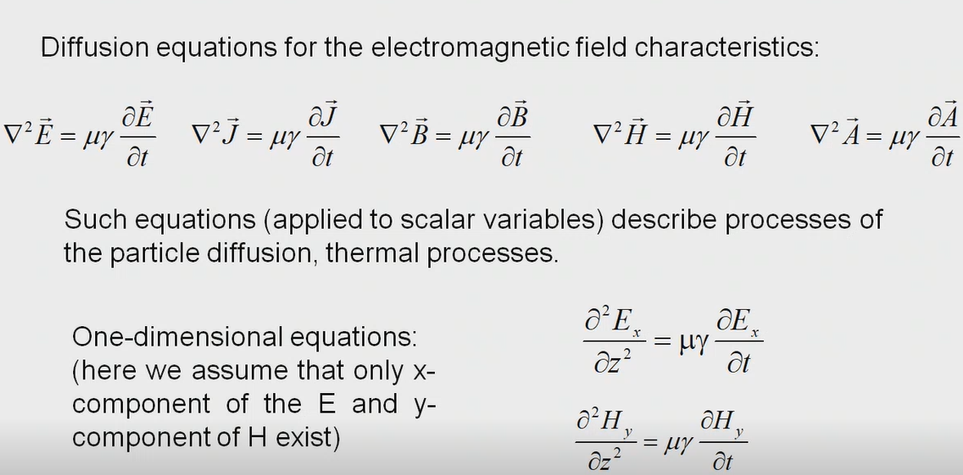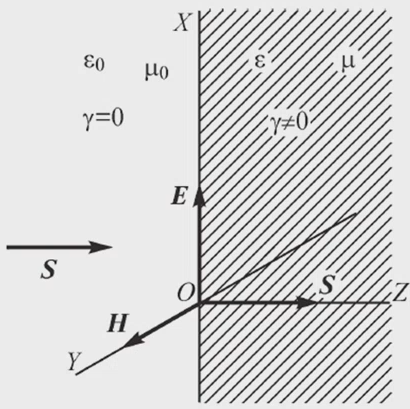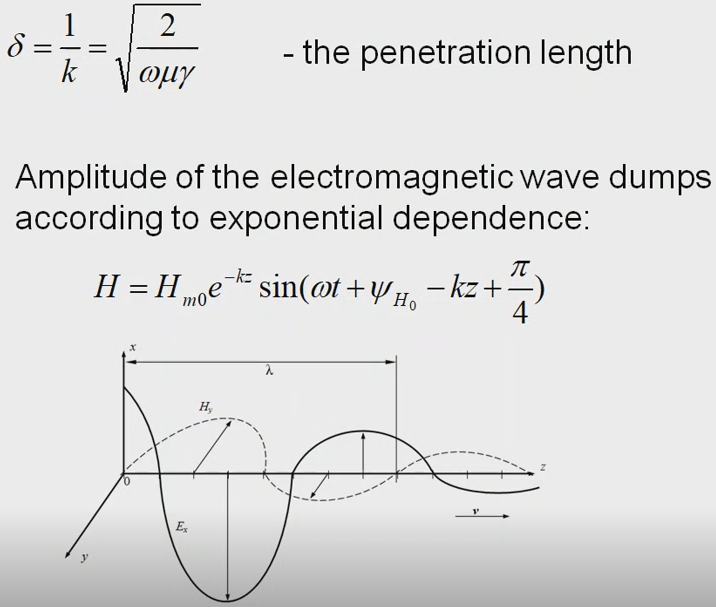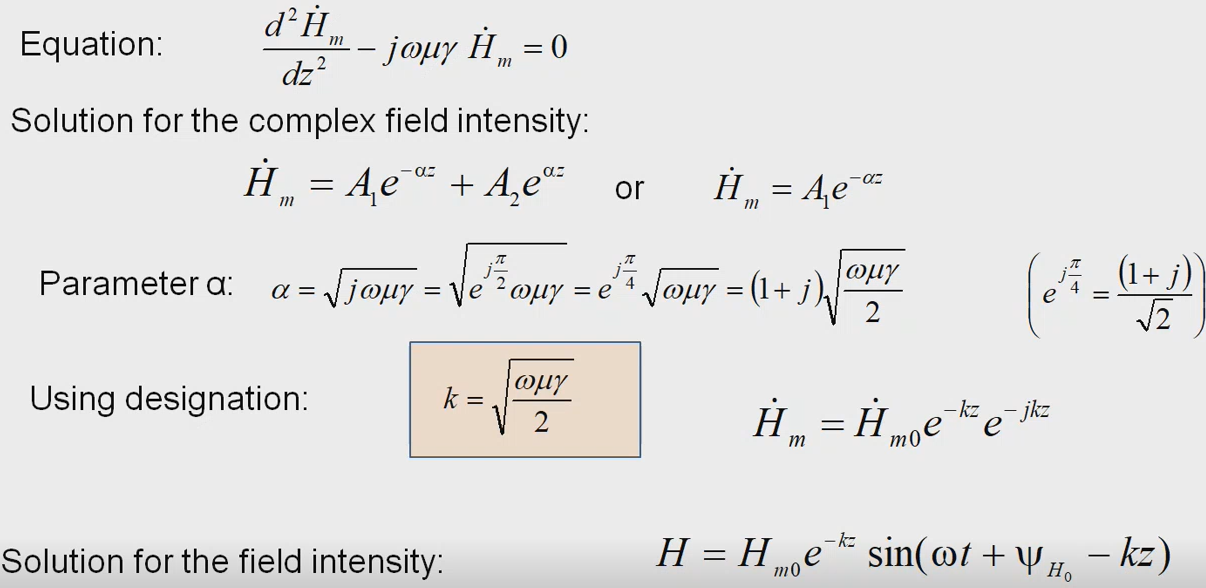
- •1. Electrostatic field. Coulomb’s law. Gauss law (Электростатическое поле. Закон Кулона. Закон Гаусса)
- •Variables and units
- •Coulomb’s Law. (ЗаконКулона)
- •Electric Field Strength e and Displacement Field d. (Напряжённостьисмещениеэлектрическогополя)
- •Gauss’ Law. (ЗаконГаусса)
- •2. Poisson’s and Laplace’s equations for the potential of electric field (Уравнения Пуассона и Лапласа для потенциала электрического поля) Electric Potential. (Электрический потенциал)
- •Poisson’s and Laplace’ s equations. (Уравнения Пуассона и Лапласа)
- •3. Electrostatic Energy (Электростатическая энергия) Electrostatic Energy (Электростатическаяэнергия)
- •Virtual experiment. (Эксперимент по нахождению энергии системы)
- •Consequences (Следствия)
- •4. Power and Joule’s Law (Энергия и закон Джоуля-Ленца)
- •5. Continuity Equation (Уравнения непрерывности) ContinuityEquation (Уравнение непрерывности)
- •Image method for the flat boundary between magnetic media (Метод изображений для плоской границы между магнитными носителями)
- •8. Static magnetic field. Biot–Savart’s Law. Ampere’s Law (Статическое магнитное поле. Закон Био–Савара. Закон Ампера)
- •Variables and units (Переменные и единицы измерения)
- •Main Relations (Основные соотношения)
- •Magnetic flux density (Индукция магнитного поля)
- •Biot-Savart’s law (Закон Био-Савара)
- •Ampere’s law (Закон полного тока)
- •The cut in the space (Разрез в пространстве)
- •Laplace equation for the scalar magnetic potential (Уравнение Лапласа для скалярного магнитного потенциала)
- •10. Vector magnetic potential. Inductance (Векторный магнитный потенциал. Индуктивность)
- •Vector magnetic potential (Векторный магнитный потенциал)
- •Magnetic flux (Магнитный поток)
- •Differential equation for the vector magnetic potential (Дифференциальное уравнение для векторного магнитного потенциала)
- •Gauging of the vector magnetic potential (Калибровка векторного магнитного потенциала)
- •Integral presentation of the vector magnetic potential (Интегральное представление векторного потенциала)
- •Inductance (Индуктивность)
- •Mutual inductance (Взаимная индуктивность)
- •Inductance of thin contours (Индуктивность тонких контуров)
- •12. Internal inductance of a thin conductor (Внутренняя индуктивность тонкого проводника) Flux linkage of a thin current layer (Потокосцепление тонкого слоя с током)
- •Internal inductance of a thin conductor (Внутренняя индуктивность тонкого проводника)
- •13. Inductance of a two wire transmission line (Индуктивность двухпроводной линии).
- •14. Variable separation method in a cylindrical coordinate system (Метод разделения переменных в цилиндрической системе координат). Application of Laplace’s equation (Применение уравнения Лапласа).
- •Angular function (Угловая функция)
- •Radial function (Радиальная функция)
- •General solution of the Laplace’s equation in a cylindrical coordinate system (Общее решение уравнения Лапласа в цилиндрической системе координат)
- •15. The Faraday’s law (Закон электромагнитной индукции).
- •Lenz’s Law (правило Ленца)
- •Induction by a temporal change of b (Индукция за счёт временного изменения b)
- •16. Induction through the motion of a conductor (Индукция за счет движения проводника).
- •17. Induction by simultaneous temporal change of b and motion of the conductor (Индукция одновременным изменением b во времени и движением проводника).
- •18. Unipolar generator (Униполярный генератор).
- •19. Hering’s paradox (Парадокс Геринга)
- •20. Diffusion of magnetic fields into conductors (Распространение электромагнитного поля в проводнике)
- •21. Periodic electromagnetic fields in conductors. (Периодическое электромагнитное поле в проводниках)
- •Penetration of the electromagnetic field into a conductor. (Проникновение электромагнитного поля в проводник)
- •The skin effect. (Скин-эффект)
- •22. Poynting theorem. (Теорема Пойнтинга) Electromagnetic Field Energy. (Энергия электромагнитного поля)
- •The rate of decrease of the electromagnetic field energy in a closed volume. (Скорость уменьшения энергии электромагнитного поля в замкнутом объёме)
- •Transmission of energy in a dc line (Передача энергии в линиях постоянного тока)
- •The field picture near the wires with current (Картина поля вблизи провода с током)
- •25. Energy flows in static electric and magnetic fields (Поток энергии в статических электрических и магнитных полях).
- •26. The reduced magnetic potential (Редуцированный магнитный потенциал). Reduced scalar magnetic potential (Редуцированный скалярный магнитный потенциал)
- •Combination of scalar magnetic potential and reduced magnetic potential (Комбинация скалярного магнитного потенциала и редуцированного магнитного потенциала)
- •27. Classification of numerical methods of the electromagnetic field modeling (Классификация численных методов моделирования электромагнитного поля).
- •Classification of the problems (Классификация проблем)
- •Classification of the methods (Классификация методов)
- •28. Method of moments
- •Discretization of the problem domain (Дискретизация проблемной области)
- •29. Basic principles of the finite element method.
- •30. Finite functions (Ограниченная функция – отлична от нуля только в пределах треугольника)
- •Simplex coordinates
- •Approximation of functions inside triangles (Аппроксимация функций внутри треугольника)
- •Approximation of the equation (Аппроксимация уравнения)
- •31. Weighted residual method (метод взвешенных невязок)
- •32. Weak formulation of the electromagnetic field modeling problem
- •33. Boundary conditions in electric and magnetic fields
- •1) First type boundary conditions
- •34. Main equations of electromagnetic field in integral form.
- •35. Main equations of electromagnetic field in differential form.
- •36. Electric field of a point charge (Электрическое поле точечного заряда)
- •37. Electric field of a uniformly charged sphere (Электрическое поле равномерно заряженной сферы)
- •38. Flat capacitor. Field. Surface charge. Capacity. (Плоский конденсатор. Поле. Поверхностный заряд. Вместимость.)
- •39.2 Inductance of a cylindrical coil with the rectangular cross section(Индуктивность цилиндрической катушки прямоугольного сечения).
- •4 0.1 Electric field induced by charged line placed above conducting surface (Электрическое поле, создаваемое заряженной линией, помещенной над проводящей поверхностью).
- •4 0.2. Magnetic field induced by the line with a current placed above a ferromagnetic surface with infinitely high magnetic permeability
20. Diffusion of magnetic fields into conductors (Распространение электромагнитного поля в проводнике)
When we shall talk about this topic, we shall assume, that’s we have conducting media, usually, it’s metal. And the electromagnetic field satisfies the Faraday’s Law and the Ampere’s Law. The specific feature of this fields is there are no displacement currents. That’s usual situation in conductors, sometimes even in conductors the displacement currents are taken into account. That is a case, which we called bad conductors. But today we shall neglect them. Inside in conducting medium there are no displacement currents and there are no free charges. In such a case the electromagnetic fields may be described by several equations:
The Faraday’s Law: |
|
In this case this is conductivity current, which may be described by the Ohm’s Law: |
|
Also, the electric and the magnetic fields satisfies the Gauss’s Law (for the magnetic field it’s a universal law, so it takes place in any case. In the case of electric field, it’s some special case: divE=0 only in a free charge medium (это следствие из divD=0)): |
|
The First Kirchhoff’s Law: |
|
|
|
Let’s make some transformations with these equations:
 Differential
equations for the electric field intensity:
Differential
equations for the electric field intensity:
M athematical transformation:
Diffusion equations for the electromagnetic field characteristics:

Such equations (applied to scalar variables) describe processes of the particle diffusion, thermal processes.
One-dimensional equations: (here we assume that only x-component of the E and y-component of H exist)
21. Periodic electromagnetic fields in conductors. (Периодическое электромагнитное поле в проводниках)
These approaches are very important form of existence of electromagnetic field – electromagnetic wave. That’s the case when the electric field intensity or magnetic field intensity depends on time according to sinusoidal function:
Quasi-stationary approaches:
![]()
The electromagnetic field is often called a planner electromagnetic wave. To describe it let’s use the complex method (using to describe currents and voltage in electromagnetic circuits):


O n
the picture: in the left part γ is equal to 0, so electromagnetic
wave comes from somewhere to this planner surface and then it starts
to penetrate the conducting material (metal):
n
the picture: in the left part γ is equal to 0, so electromagnetic
wave comes from somewhere to this planner surface and then it starts
to penetrate the conducting material (metal):
Equation: |
|
Solution for the complex field intensity: |
|
Parameter α: |
|
Using designation: |
|
Solution for the field intensity: |
|
(A2=0, because: decreases, when we are travelling into the conducting medium and field intensity is growing to infinity)
Penetration of the electromagnetic field into a conductor. (Проникновение электромагнитного поля в проводник)
E verywhere
inside the conductor the magnetic field intensity will be oscillating
function, but the amplitude of this oscillation will be less and
less:
verywhere
inside the conductor the magnetic field intensity will be oscillating
function, but the amplitude of this oscillation will be less and
less:
The penetration length:
Amplitude of the electromagnetic wave dumps according to exponential dependence:




